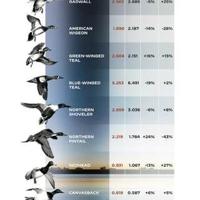Waterfowlers are preparing to head to their favorite waterhole this weekend for the start of the Oklahoma Waterfowl season. Youth, military and veterans got the early jump on things last week and from the sound of it, it was a good start.
The waterfowl season runs Nov. 11-26 and Dec. 2-Jan28 for most of the state. Geese and crane seasons are already open as well.
Checking some waterfowl reports may get hunters a little excited. Salt Plains National Wildlife Refuge is reporting much increased bird activity with 9,249 Ducks, 12,650 Geese, 25,179 Sandhill Cranes, 19 Eagles and 20 Whooping Cranes in last weeks report.
All that is needed is a couple of good cold fronts, and perhaps a little more rain to get things going.
Speaking of reports Ducks Unlimited released its 2023 Status of Waterfowl last week and despite a continuing drought across much of the duck producing areas of the country, bird numbers are not as bad as many biologist had predicted.
For over 65 years, federal, state, and provincial agencies have conducted surveys to estimate numbers of ducks, geese, and swans in North America. Those results are used to monitor waterfowl abundance and habitats, inform harvest regulations, and grow our understanding of populations and conservation needs. Results are summarized each year in the USFWS’s Waterfowl Population Status report to provide a comprehensive review of the abundance of North America’s ducks, geese, and swans.
Because the traditional survey area encompasses the highly productive Prairie Pothole Region, where habitat conditions and duck populations fluctuate in response to periodic wet and dry cycles, the fortunes of most waterfowl populations—and hunters—are tied to these variable conditions. The estimate for total ducks in this area, including the 16 most common duck species, was 32.3 million birds, a 7 percent drop from 2022 and 9 percent below the long-term average.
Estimates for several dabbling duck species in the traditional survey area continued to decline from record highs during the previous decade. The mallard breeding population was estimated at 6.1 million birds, an 18 percent drop from 2022 and a level 23 percent below the long-term average. This was the lowest mallard estimate since 1994. Similar declines were seen in blue-winged teal and American wigeon. Despite this year’s decrease, bluewing numbers remained near their long-term average. Estimates for American wigeon, however, were 28 percent below their long-term average.
Hunters are encouraged to check out all of the regulations and bag limits for Oklahoma’s season at the Wildlife Departments webside. Also don’t forget the purchase State and Federal Waterfowl Stamps and complete the HIP survey before heading to the field.
Want to reach a local audience and grow your business?
Our website is the perfect platform to connect with engaged readers in your local area.
Whether you're looking for banner ads, sponsored content, or custom promotions, we can tailor a package to meet your needs.
Contact us today to learn more about advertising opportunities!
CONTACT US NOW






